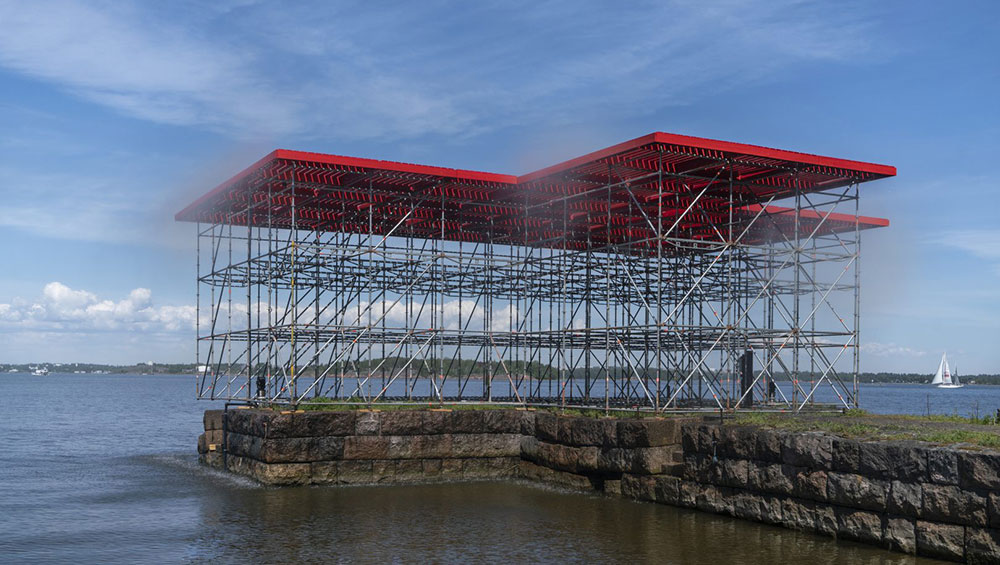
Jaakko Niemelä’s Quay 6, 2021. © Maija Toivanen/HAM/Helsinki Biennial 2021.
Helsinki Biennial: The Same Sea
Vallisaari Island, Helsinki, 12 June – 26 September 2021
Helsinki Design Week
Various venues, Helsinki, 9-19 September 2021
by VERONICA SIMPSON
Context, as they say, is everything. When I first heard about the Helsinki Biennial’s proposition, back in 2019 – an off-grid, low-carbon, site-specific contemplation of planetary and cultural vulnerabilities, held on an abandoned island that had formerly been occupied by the Russian military – the Finns had my attention. Now, following a global pandemic that has done more to spotlight human and ecological frailty than pretty much any event in recent history, that theme has gained a huge amount of additional traction; if there was one contemporary art festival for which I was ready to step on a plane and endure the pandemic-related rigmarole required of those who dare to leave (and re-enter) the UK in 2021, this would be it. One step back for my almost zero carbon footprint for the previous 18 months, yes, but a giant step forward in celebrating an arts platform that dwells on issues vital to humankind, delivered in a way that addresses social, environmental and cultural sustainability.
.jpg)
Laura Könönen, No Heaven Up in the Sky, 2021. Photo: Veronica Simpson.
From the creation of these 41 artworks, many made entirely on site, often from local materials, to the free ferry that takes you from the mainland to the island and – last but not least - free entry to all visitors, the Helsinki Biennial was standing for a more carbon and people friendly way of doing art festivals, and the sustainability consultant it hired (Kiira Kivisaari, allegedly one of the first to be employed for a project on this scale) seems to have covered all the bases.
.jpg)
Katharina Grosse, Shutter Splinter ( detail), 2021. Photo: Veronica Simpson.
But would the work deliver? On paper, it was an interesting selection, majoring on Finnish artists, but with some international heavyweights (Alicja Kwade, Katharina Grosse and Paweł Althamer among them), and a checklist of the kind of materials and preoccupations you might expect from today’s more eco-conscious exhibitions: mycelial sculptures, works that articulate the sounds of decomposing trees, structures that alert us to rising sea levels, others that reference connections between cellular and intergalactic geometries. But would it add up to more than the sum of its parts, in the flesh? I would say wholeheartedly: yes.
The 20-minute ferry ride from Helsinki landed visitors on the north shore, to be greeted by a deserted but imposing 19th-century red-brick building that the Russian military constructed to house the “pilots” who, in previous centuries, had guided ships into Helsinki’s island-strewn harbour in their small vessels. Most of the buildings left here are from that Russian occupation, we were told by our guide. Pretty much uninhabited since Finnish independence in 1917, Vallisaari is now remarkable for the wildlife that has made a home here, including 1,000 kinds of butterflies and several important bat species, which flourished undisturbed until the public were allowed access in 2016.
-2012,-by-Janet-Cardiff-and-George-Bures-Miller.jpg)
Listening to FOREST (for a thousand years..) 2012, by Janet Cardiff and George Bures Miller. Photo: Veronica Simpson.
We trudged along a tree-lined path, the just-turning leaf canopy illuminated by some welcome September sunshine. We were told by our guide that this island used to be known as Pond Island because of the precious freshwater pool at its centre, a vital resource for visiting sailors and residents – and there was, during occupation, a 300-strong community living here.
The first work we encountered was Jaakko Niemelä’s Quay 6 (2021), a thick, red platform perched on top of metal scaffolding on a disused stone quay. This vivid red, structural marker is set six metres above sea level, to show how high the waters will rise if we fail to amend our fossil fuel-guzzling ways – and the title of the biennial, The Same Sea reminds us that, although our oceans and seas have different names, it is the same body of water that dominates the planet. A constant, fine spray poured down from the nearest edge of the platform, spattering those of us who got too close - a reminder, perhaps, that this outcome is nearer than we think.
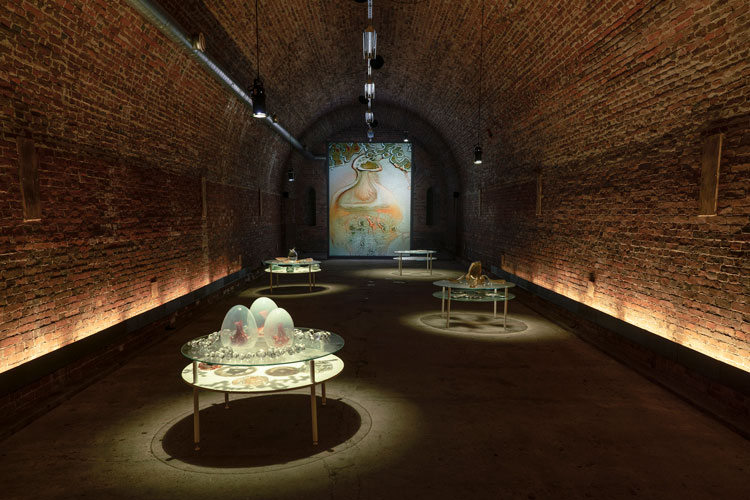
Tuomas A Laitinen, ΨZone, 2021. © Maija Toivanen/HAM/Helsinki Biennial 2021.
Behind us was an abandoned red-brick building with grass growing out of the roof. It houses a gunpowder tunnel and – for now - an atmospheric installation, ΨZone (2021), by Tuomas A Laitinen, one of the big Finnish art stars here. A compelling soundtrack of plips, droplets, low booms and crackles percolated through the tunnel, as we moved around spot-lit, circular islands of curious glass creatures and their dissected parts. The installation is a combination of subterranean, aquatic and other worldly. A large screen at the end displayed an animation of what appear to be cells and microbes combining and shifting and slowly transforming into waves. Our guide suggested this work is supposed to be “like an alien zone or giant microscope. It examines the formation of knowledge within complex systems.” The title, ΨZone, apparently refers to the wave functions of quantum mechanics’ many-worlds theory, and the psyche. It is definitely food for thought, intellectually, emotionally and visually.
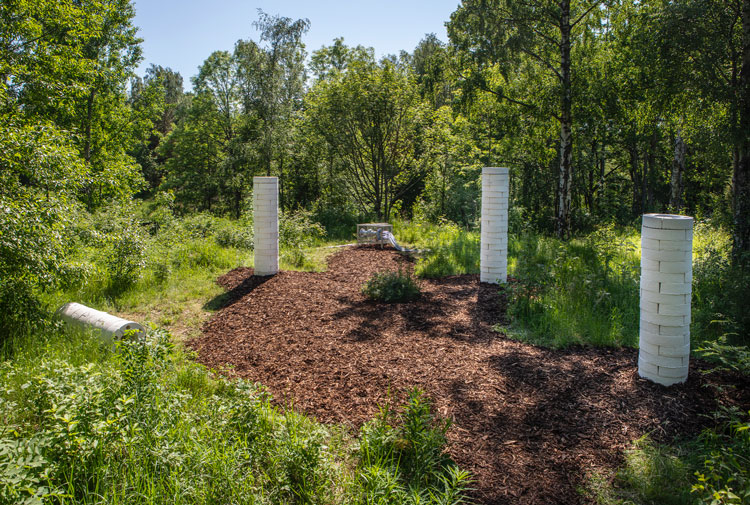
Teemu Lehmusruusu, House of Polypores, 2021. © Kirsi Halkola/HAM/Helsinki Biennial 2021.
Further along the path, the Finnish artist Teemu Lehmusruusu had built tall, white, cylindrical pipes out of mycelial-moulded blocks, and placed them over rotting tree stumps, for House of Polypores (2021). An elaborate mechanism incorporating organ pipes, a solar-powered amplifier and sensors in the pillars allowed us to “listen” to the sound of these trees decaying. Lehmusruusu’s sculptures were translating the sound into organic music. If you leaned in to each pillar, the hum or low thrum was clearly audible, though not loud. Different “tones” emanated from each tree.
Up past one of many creepy, boarded-up wooden buildings, we came to the old schoolhouse, against whose rotting structure Grosse has exploded rainbow colours – it was as if she had thrown a giant paint bomb at the building. Her “bomb” fans out in a star shape, thanks to jagged panels she added to the school’s own tumbledown timber structure. The paint will apparently slowly vanish when the vegetation begins its new seasonal cycle. The schoolhouse – already infested with toxic actinomyces – is due for demolition anyway.
-landscape.jpg)
Alicja Kwade, Pars pro Toto, 2019. Landscape. Photo: Veronica Simpson.
Then we arrived at Kwade’s Pars pro Toto (2018). The title means “a part for the whole” and apparently refers to the repetition of so many similar structures in our universe, from atoms to galaxies. Eight huge stone spheres lay scattered across a rocky shore, like marbles thrown by a giant. They looked at once serene and surreal. Wordlessly, all those in our group of visitors found a spot to sit and contemplate this vista, admiring how right and yet how wrong they looked, carved from quarries from every continent (this one’s carbon footprint is not so neutral, clearly). We were encouraged to caress or even hug them, but they are cold to the touch.
.jpg)
Tadashi Kawamata, Vallisaari Lighthouse, 2021. Photo: Veronica Simpson.
We walked on to Tadashi Kawamata’s Vallisaari Lighthouse (2021). Kawamata likes to create structures from waste and surplus materials, making sure that he leaves his chosen site exactly as he found it. This tower of salvaged wood sat on top of an old elevator shaft and reached several metres high. Metallic, corrugated panels were placed on the interior of the frame at the very top, to catch the setting sun or moonlight. While I did not witness it at night, I can imagine that seeing this lighthouse glinting by moonlight during the summer nights must have been entrancing, flagging up the island’s emptiness with this single bright spot.
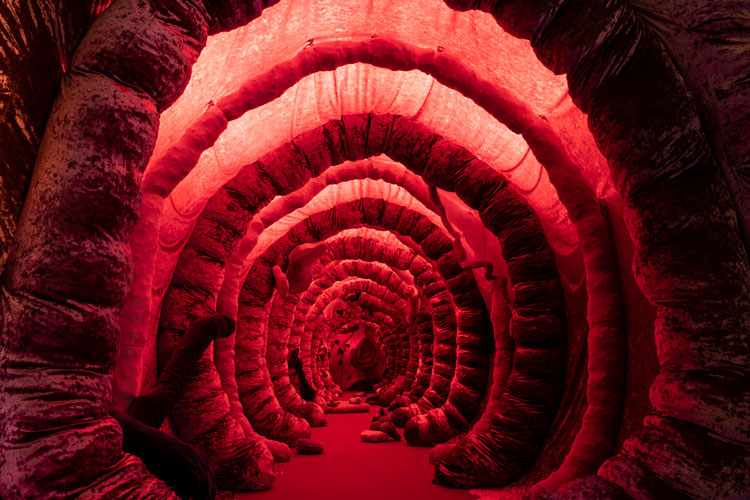
Dafna Maimon, Indigestibles, 2021. © Maija Toivanen/HAM/Helsinki Biennial 2021.
Dafna Maimon’s Indigestibles (2021) was situated nearby, in an underground tunnel - another former gunpowder cellar – which she transformed into the billowing red interior of the human digestive system. Through video, installation, sound and performance, she created a “portrait of Shelly, a stressed-out, self-destructive woman whose life lacks meaning and content. Bacteria, intestines, internal organs and undigested food are interwoven in a biological landscape scarred by traumatic experiences.” Sadly, it hadn’t yet been opened during our early morning press tour.
-landscape.jpg)
Kyungwoo Chun, Islands of island, 2021. Photo: Veronica Simpson.
Glowing red against the lush green grass just around the corner, however, were Kyungwoo Chun’s little bundles: messages written by visitors to this biennial – he suggested they compose them to people they love – had been wrapped around objects they found on their visit, from sticks to moss to shells, and these bundles were piled in neat rows beneath a tree. By the end of the biennial, they stretched almost as far as the nearby bunker, the Alexander Battery. Chun devised this work, called Islands of Island (2021), to remind us of the importance of speaking and listening, especially in an age of information overload. In front of the same bunker, Laura Könönen had placed huge pieces of sky – fragments of Finnish rock (diorite) whose smoothed, elliptical upper surfaces are layered with bright, sky-blue paint. Called No Heaven Up in the Sky (2021), it looked as if the sky had indeed fallen down.
.jpg)
Sari Palosaari, Eons and Instants, 2021. Photo: Veronica Simpson.
Meanwhile, making the most of the gloomy atmosphere inside the Alexander Battery were a rich assortment of works, including Sari Palosaari’s Eons and Instants (2021): rocks on mirrored surfaces had been filled with soundless cracking agents and mineral powders, so that they slowly split and crumbled during the duration of the biennial.
.jpg)
Samnang Khvay’s film Preah Kunlong (The Way of the Spirit, 2016-20). Photo: Veronica Simpson.
Samnang Khvay’s film Preah Kunlong (The Way of the Spirit, 2016-20) featured a Cambodian tribal dancer in a remote jungle landscape acting out ritual dances in animal masks, to highlight the connection between humans and nature.
.jpg)
Helsinki Satellite Reef, 2021, crocheted by Margaret & Christine Wertheim and the Institute for Figuring. Photo: Veronica Simpson.
Also in this tunnel network was the exquisitely coloured and conjured Helsinki Satellite Reef (2021), crocheted by Margaret & Christine Wertheim and the Institute for Figuring. And there was so much more, a lot of which there wasn’t time to see in one morning (there were several filmed works that would have taken up to an hour to view). Those lucky enough to live in Helsinki would have been able to take an entire day, or perhaps enjoy the pleasure of several repeated visits.
But on the strength of seeing two-thirds of the work, it was clear that the curators, Pirkko Siitari and Taru Tappola (respectively head of exhibitions and head of public art for Helsinki Art Museum, working closely with the museum’s director, Maija Tanninen-Mattila) are to be congratulated. The quality of the work, the breadth and depth of the artists’ investigations, the degree to which the place, the works and how they were sited enriched the experience of exploring those themes, was every bit as rewarding as I had hoped.
All this navel-/sky-gazing about who we are, why we’re here, is given so much more weight within the context of Helsinki’s own approach to cultivating community and culture in balance with nature, as expressed in Helsinki Design Week, which ran concurrently with my biennial visit. The Finns’ approach to design is hugely respectful of their own design legacy, celebrating the heroes of the past – such as architects Alvar and Aino Aalto, whose enduring sensibility still educates visitors to their home and studio in Helsinki – and incorporating the best of their art and design talents in their own distinctive brands of glassware (Littala) and ceramics (Arabia), as well as all manner of furniture designs. During the design week, an exhibition of Littala’s impressive history and collaborations with artists – Finnish and international – was on display at the Design Museum. Also, about 10km from Helsinki, at the Espoo Museum of Modern Art, was an innovative presentation, part archive, part storage and part exhibition, of two leading lights in 20th-century Finnish design, Rut Bryk and her husband, Tapio Wirkkala.
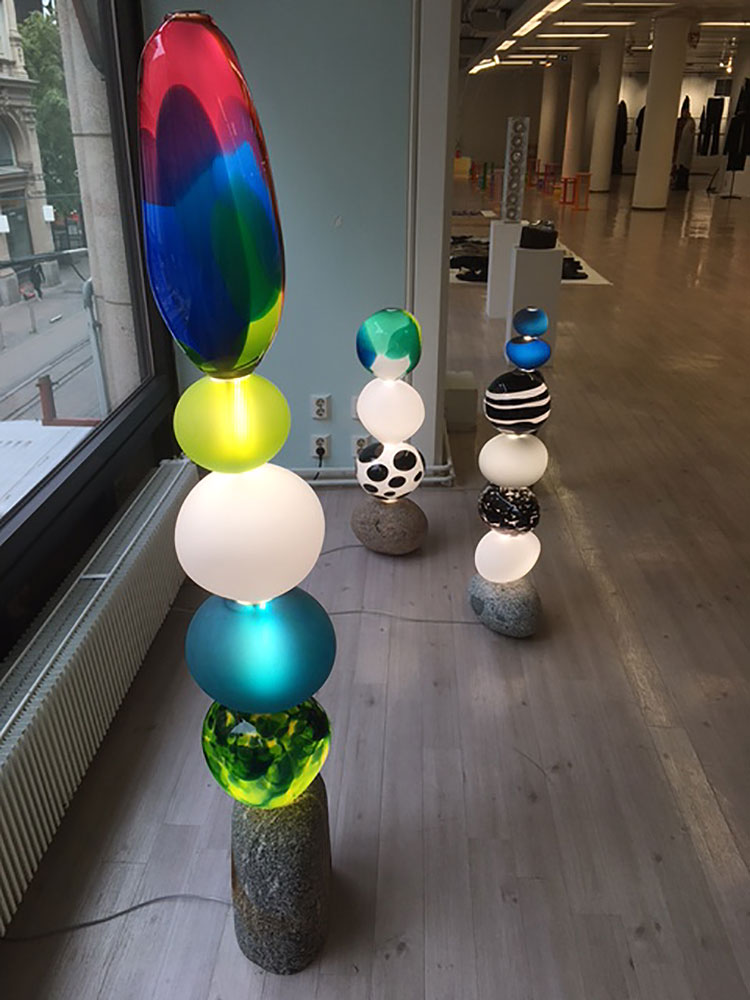
Glass Art, installation view. Photo: Veronica Simpson.
Beyond that appreciation of design legacy, the question that underpinned this year’s theme for the week - What Is Wise to Design Now? – was interrogated in myriad ways. The need to encourage a more conscious kind of consumerism was one answer, and to that end Mirkku Kullberg, founder of Glasshouse Helsinki - originally a forum for mentoring and supporting new artists and designers – set up shop in a disused department store (apparently the country’s first) designed by the Finnish architect Selim A Lindqvist in 1900. Here she programmed a daring first floor of art, including the truly disturbing 2013 film Arkhipelagos (Navigating the Tides of Time) by IC-98. A wide screen animation of roiling and stormy seas, it turns out to be a sea over a city – its spires and pylons visible over the waves. The message is clear: this is what our world will look like if we don’t get a handle on our wasteful ways. Further round that first floor was an exhibition on prints and printmaking, a collection of fine art glass, an interior igloo woven from reeds, and a “round table” that happened to be oblong, where makers, designers, artists and consumers discussed the leading issues in a series of talks. I like that idea: a shop that really wants to make us think about what and why we are consuming!
Also to that end, the ground floor atrium hosted an exhibition by students of Aalto University, exploring the sustainability credentials of the most commonly used materials – after all, we can’t expect people to shop sustainably if they have no clue about what each material and process costs the planet. Elsewhere, a fine collection of locally made, enduringly appealing artisan products was available, all curated by photographer Katja Hagelstam, founder of the Lokal Gallery. One of Finland’s rising star fashion brands was available here: Nomen Nescio, whose gender-neutral clothes comprise an all-black core collection, which continues from one year to the next (with the odd special edition for variety).
A respect for craft and creativity and a love of nature are a strong part of Finnish culture, which helps in fostering a spirit of sustainable consumerism. All these were visible at Littow Architects’ Majamaja Cabin, a portable, self-sustaining, off-grid cabin that you can ship easily by boat or car to the island or coastal spot of your choice. The charming prototype we visited is currently hired out at about €300 a night, and a little village of such cabins is planned for summer 2022.
But that’s where the furniture element of any design fair always strikes a false note when it comes to sustainability: the industry’s economy is still entirely driven by newness and reinvention. This year’s HDW may have seemed eco-friendlier and more and ethical compared with most other design fairs, because the Habitare furniture fair, which usually runs concurrently, was cancelled due to fears about the Covid risk posed by its exhibition format. But the problem remains. However, Anni Korkman, programme director of the Helsinki Design Week, insisted that if design literacy and customer education is embedded into the programme for every design fair, then these fairs have a key role to play. She says: “If people understand the value of good design, and know what good design looks like – in art, in homes, in buildings – then they can make better choices and participate in the debate.”
To that end, Helsinki Design Week runs an impressive array of year-round education activities and events. And it is working closely with other furniture fairs to advise and support them along their own sustainability and design literacy journeys. It makes you hopeful. But it also makes me wonder how - having done so well to occupy the ethical, aesthetic and cultural high ground in this year’s design and art festivals – it can hope to deliver something as good (or could we even hope for better?) next time.
• Sadly, the main exhibition of Helsinki Design Week, which was to have taken place on the third and fourth floors of Glasshouse, were cancelled due to Covid.